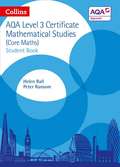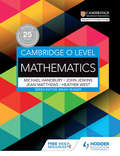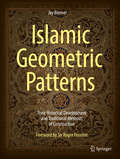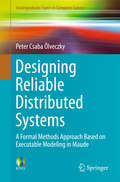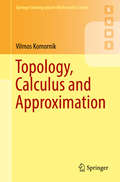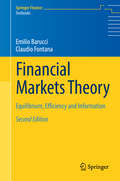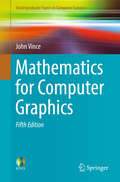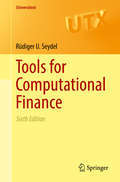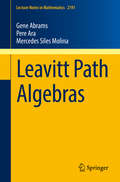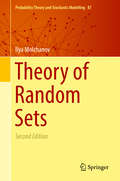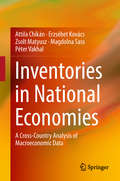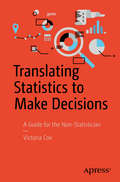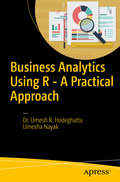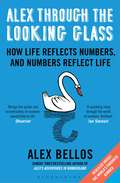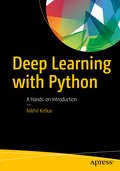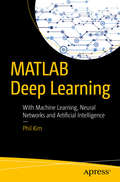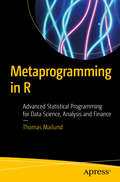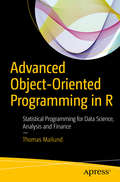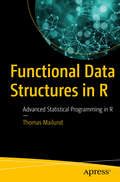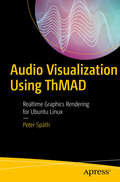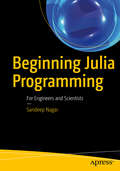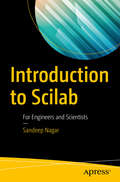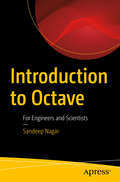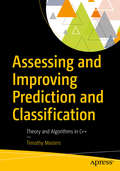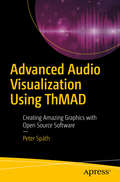- Table View
- List View
AQA Core Maths — AQA Level 3 Mathematical Studies Student Book (Aqa Core Maths Ser.)
by Jack Abramsky Huw Kyffin Helen Ball Kevin Davis Peter RansomExam Board: AQA Level & Subject: Level 3 Maths First teaching: September 2014 First exams: June 2016 AQA approved Engage and motivate your AQA Core Maths students with a rich variety of real-life data and contexts. • Help students to access the AQA Level 3 Mathematical Studies specification with explanations, examples and plenty of practice. • Help all students reach their potential with differentiated exercises and project work. • Capture students’ interest with a real-world chapter opener and Mathematics in the real world sections throughout • Prepare for exams with exam-style questions in chapter 14 • Get students talking with Discussions that include open-ended questions • Focus on technical vocabulary and unfamiliar terms with key term definitions on the page • Draw together learning from each chapter with a Case Study • Provide extended tasks with the Project work sections at the end of each chapter • Assess your learning before moving on with the Check your progress feature • Check your understanding with answers at the back
Cambridge O Level Mathematics (PDF)
by Heather West Mike Handbury John Jeskins Jean MatthewsWe are working with Cambridge International Examinations to gain endorsement for this new, full-colour textbook matched exactly to the syllabus.- Matched exactly to the latest Cambridge O level syllabus- Includes non-calculator questions- Supports revision through a range of past paper questions
Islamic Geometric Patterns: Their Historical Development and Traditional Methods of Construction
by Jay Bonner Craig KaplanThe main focus of this unique book is an in-depth examination of the polygonal technique; the primary method used by master artists of the past in creating Islamic geometric patterns. The author details the design methodology responsible for this all-but-lost art form and presents evidence for its use from the historical record, both of which are vital contributions to the understanding of this ornamental tradition. Additionally, the author examines the historical development of Islamic geometric patterns, the significance of geometric design within the broader context of Islamic ornament as a whole, the formative role that geometry plays throughout the Islamic ornamental arts (including calligraphy, the floral idiom, dome decoration, geometric patterns, and more), and the underexamined question of pattern classification.Featuring over 600 beautiful color images, Islamic Geometric Patterns: Their Historical Development and Traditional Methods of Construction is a valuable addition to the literature of Islamic art, architecture and geometric patterns. This book is ideal for students and scholars of geometry, the history of mathematics, and the history of Islamic art, architecture, and culture. In addition, artists, designers, craftspeople, and architects will all find this book an exceptionally informative and useful asset in their fields.Jay Bonner is an architectural ornamentalist and unaffiliated scholar of Islamic geometric design. He received his MDes from the Royal College of Art in London (1983). He has contributed ornamental designs for many international architectural projects, including the expansion of both the al-Masjid al-Haram (Grand Mosque) in Mecca, and the al-Masjid an Nawabi (Prophet’s Mosque) in Medina, as well the Tomb of Sheikh Hujwiri in Lahore, and the Ismaili Centre in London – to name but a few. He is committed to the revitalization of Islamic geometric design through the teaching of traditional methodological practices. To this end, in addition to publishing, Jay Bonner has lectured and taught design seminars at many universities and conferences in North America, Europe, North Africa and Asia.
Designing Reliable Distributed Systems: A Formal Methods Approach Based on Executable Modeling in Maude (Undergraduate Topics in Computer Science)
by Peter Csaba ÖlveczkyThis classroom-tested textbook provides an accessible introduction to the design, formal modeling, and analysis of distributed computer systems. The book uses Maude, a rewriting logic-based language and simulation and model checking tool, which offers a simple and intuitive modeling formalism that is suitable for modeling distributed systems in an attractive object-oriented and functional programming style.Topics and features: introduces classical algebraic specification and term rewriting theory, including reasoning about termination, confluence, and equational properties; covers object-oriented modeling of distributed systems using rewriting logic, as well as temporal logic to specify requirements that a system should satisfy; provides a range of examples and case studies from different domains, to help the reader to develop an intuitive understanding of distributed systems and their design challenges; examples include classic distributed systems such as transport protocols, cryptographic protocols, and distributed transactions, leader election, and mutual execution algorithms; contains a wealth of exercises, including larger exercises suitable for course projects, and supplies executable code and supplementary material at an associated website.This self-contained textbook is designed to support undergraduate courses on formal methods and distributed systems, and will prove invaluable to any student seeking a reader-friendly introduction to formal specification, logics and inference systems, and automated model checking techniques.
Topology, Calculus and Approximation (Springer Undergraduate Mathematics Series)
by Vilmos KomornikPresenting basic results of topology, calculus of several variables, and approximation theory which are rarely treated in a single volume, this textbook includes several beautiful, but almost forgotten, classical theorems of Descartes, Erdős, Fejér, Stieltjes, and Turán. The exposition style of Topology, Calculus and Approximation follows the Hungarian mathematical tradition of Paul Erdős and others. In the first part, the classical results of Alexandroff, Cantor, Hausdorff, Helly, Peano, Radon, Tietze and Urysohn illustrate the theories of metric, topological and normed spaces. Following this, the general framework of normed spaces and Carathéodory's definition of the derivative are shown to simplify the statement and proof of various theorems in calculus and ordinary differential equations. The third and final part is devoted to interpolation, orthogonal polynomials, numerical integration, asymptotic expansions and the numerical solution of algebraic and differential equations.Students of both pure and applied mathematics, as well as physics and engineering should find this textbook useful. Only basic results of one-variable calculus and linear algebra are used, and simple yet pertinent examples and exercises illustrate the usefulness of most theorems. Many of these examples are new or difficult to locate in the literature, and so the original sources of most notions and results are given to help readers understand the development of the field.
Financial Markets Theory: Equilibrium, Efficiency and Information (Springer Finance)
by Emilio Barucci Claudio FontanaThis work, now in a thoroughly revised second edition, presents the economic foundations of financial markets theory from a mathematically rigorous standpoint and offers a self-contained critical discussion based on empirical results. It is the only textbook on the subject to include more than two hundred exercises, with detailed solutions to selected exercises.Financial Markets Theory covers classical asset pricing theory in great detail, including utility theory, equilibrium theory, portfolio selection, mean-variance portfolio theory, CAPM, CCAPM, APT, and the Modigliani-Miller theorem. Starting from an analysis of the empirical evidence on the theory, the authors provide a discussion of the relevant literature, pointing out the main advances in classical asset pricing theory and the new approaches designed to address asset pricing puzzles and open problems (e.g., behavioral finance). Later chapters in the book contain more advanced material, including on the role of information in financial markets, non-classical preferences, noise traders and market microstructure.This textbook is aimed at graduate students in mathematical finance and financial economics, but also serves as a useful reference for practitioners working in insurance, banking, investment funds and financial consultancy. Introducing necessary tools from microeconomic theory, this book is highly accessible and completely self-contained.Advance praise for the second edition:"Financial Markets Theory is comprehensive, rigorous, and yet highly accessible. With their second edition, Barucci and Fontana have set an even higher standard!"Darrell Duffie, Dean Witter Distinguished Professor of Finance, Graduate School of Business, Stanford University"This comprehensive book is a great self-contained source for studying most major theoretical aspects of financial economics. What makes the book particularly useful is that it provides a lot of intuition, detailed discussions of empirical implications, a very thorough survey of the related literature, and many completely solved exercises. The second edition covers more ground and provides many more proofs, and it will be a handy addition to the library of every student or researcher in the field."Jaksa Cvitanic, Richard N. Merkin Professor of Mathematical Finance, Caltech"The second edition of Financial Markets Theory by Barucci and Fontana is a superb achievement that knits together all aspects of modern finance theory, including financial markets microstructure, in a consistent and self-contained framework. Many exercises, together with their detailed solutions, make this book indispensable for serious students in finance."Michel Crouhy, Head of Research and Development, NATIXIS
Mathematics for Computer Graphics (Undergraduate Topics in Computer Science)
by John VinceJohn Vince explains a wide range of mathematical techniques and problem-solving strategies associated with computer games, computer animation, virtual reality, CAD and other areas of computer graphics in this completely revised and expanded fifth edition.The first five chapters cover a general introduction, number sets, algebra, trigonometry and coordinate systems, which are employed in the following chapters on vectors, matrix algebra, transforms, interpolation, curves and patches, analytic geometry and barycentric coordinates. Following this, the reader is introduced to the relatively new topic of geometric algebra, followed by two chapters that introduce differential and integral calculus. Finally, there is a chapter on worked examples.Mathematics for Computer Graphics covers all of the key areas of the subject, including:· Number sets· Algebra· Trigonometry· Coordinate systems· Determinants· Vectors· Quaternions· Matrix algebra· Geometric transforms· Interpolation· Curves and surfaces· Analytic geometry· Barycentric coordinates· Geometric algebra· Differential calculus· Integral calculusThis fifth edition contains over 120 worked examples and over 320 colour illustrations, which are central to the author’s descriptive writing style. Mathematics for Computer Graphics provides a sound understanding of the mathematics required for computer graphics, giving a fascinating insight into the design of computer graphics software and setting the scene for further reading of more advanced books and technical research papers.
Tools for Computational Finance (Universitext)
by Rüdiger U. SeydelComputational and numerical methods are used in a number of ways across the field of finance. It is the aim of this book to explain how such methods work in financial engineering. By concentrating on the field of option pricing, a core task of financial engineering and risk analysis, this book explores a wide range of computational tools in a coherent and focused manner and will be of use to anyone working in computational finance. Starting with an introductory chapter that presents the financial and stochastic background, the book goes on to detail computational methods using both stochastic and deterministic approaches.Now in its sixth edition, Tools for Computational Finance has been significantly revised and contains: Several new parts such as a section on extended applications of tree methods, including multidimensional trees, trinomial trees, and the handling of dividends;Additional material in the field of generating normal variates with acceptance-rejection methods, and on Monte Carlo methods;115 exercises, and more than 100 figures, many in color.Written from the perspective of an applied mathematician, all methods are introduced for immediate and straightforward application. A ‘learning by calculating’ approach is adopted throughout this book, enabling readers to explore several areas of the financial world.Interdisciplinary in nature, this book will appeal to advanced undergraduate and graduate students in mathematics, engineering, and other scientific disciplines as well as professionals in financial engineering.
Leavitt Path Algebras (Lecture Notes in Mathematics #2191)
by Gene Abrams Pere Ara Mercedes Siles MolinaThis book offers a comprehensive introduction by three of the leading experts in the field, collecting fundamental results and open problems in a single volume.Since Leavitt path algebras were first defined in 2005, interest in these algebras has grown substantially, with ring theorists as well as researchers working in graph C*-algebras, group theory and symbolic dynamics attracted to the topic. Providing a historical perspective on the subject, the authors review existing arguments, establish new results, and outline the major themes and ring-theoretic concepts, such as the ideal structure, Z-grading and the close link between Leavitt path algebras and graph C*-algebras. The book also presents key lines of current research, including the Algebraic Kirchberg Phillips Question, various additional classification questions, and connections to noncommutative algebraic geometry.Leavitt Path Algebras will appeal to graduate students and researchers working in the field and related areas, such as C*-algebras and symbolic dynamics. With its descriptive writing style, this book is highly accessible.
Theory of Random Sets (Probability Theory and Stochastic Modelling #87)
by Ilya MolchanovThis monograph, now in a thoroughly revised second edition, offers the latest research on random sets. It has been extended to include substantial developments achieved since 2005, some of them motivated by applications of random sets to econometrics and finance. The present volume builds on the foundations laid by Matheron and others, including the vast advances in stochastic geometry, probability theory, set-valued analysis, and statistical inference. It shows the various interdisciplinary relationships of random set theory within other parts of mathematics, and at the same time fixes terminology and notation that often vary in the literature, establishing it as a natural part of modern probability theory and providing a platform for future development. It is completely self-contained, systematic and exhaustive, with the full proofs that are necessary to gain insight. Aimed at research level, Theory of Random Sets will be an invaluable reference for probabilists; mathematicians working in convex and integral geometry, set-valued analysis, capacity and potential theory; mathematical statisticians in spatial statistics and uncertainty quantification; specialists in mathematical economics, econometrics, decision theory, and mathematical finance; and electronic and electrical engineers interested in image analysis.
Inventories in National Economies: A Cross-Country Analysis of Macroeconomic Data
by Attila Chikán Erzsébet Kovács Zsolt Matyusz Magdolna Sass Péter VakhalThis book introduces a new approach in the field of macroeconomic inventory studies: the use of multivariate statistics to evaluate long-term characteristics of inventory investments in developed countries. By analyzing a 44-year period series of annual inventory change in percentage of GDP in a set of OECD countries, disclosing their relationship to growth, industry structure and alternative uses of GDP (fixed capital investments, foreign trade and consumption), it fills a gap in the economic literature. It is generally accepted that inventories play an important role in all levels of the economy. However, while there is extensive literature on micro- (and even item-) level inventory problems, macroeconomic inventory studies are scarce. Both the long-term processes of inventory formation and their correlation with other macroeconomic factors provide interesting conclusions about economic changes and policies in our immediate past, and present important insights for the future.
Translating Statistics to Make Decisions: A Guide for the Non-Statistician
by Victoria CoxExamine and solve the common misconceptions and fallacies that non-statisticians bring to their interpretation of statistical results. Explore the many pitfalls that non-statisticians—and also statisticians who present statistical reports to non-statisticians—must avoid if statistical results are to be correctly used for evidence-based business decision making. Victoria Cox, senior statistician at the United Kingdom’s Defence Science and Technology Laboratory (Dstl), distills the lessons of her long experience presenting the actionable results of complex statistical studies to users of widely varying statistical sophistication across many disciplines: from scientists, engineers, analysts, and information technologists to executives, military personnel, project managers, and officials across UK government departments, industry, academia, and international partners. The author shows how faulty statistical reasoning often undermines the utility of statistical results even among those with advanced technical training. Translating Statistics teaches statistically naive readers enough about statistical questions, methods, models, assumptions, and statements that they will be able to extract the practical message from statistical reports and better constrain what conclusions cannot be made from the results. To non-statisticians with some statistical training, this book offers brush-ups, reminders, and tips for the proper use of statistics and solutions to common errors. To fellow statisticians, the author demonstrates how to present statistical output to non-statisticians to ensure that the statistical results are correctly understood and properly applied to real-world tasks and decisions. The book avoids algebra and proofs, but it does supply code written in R for those readers who are motivated to work out examples. Pointing along the way to instructive examples of statistics gone awry, Translating Statistics walks readers through the typical course of a statistical study, progressing from the experimental design stage through the data collection process, exploratory data analysis, descriptive statistics, uncertainty, hypothesis testing, statistical modelling and multivariate methods, to graphs suitable for final presentation. The steady focus throughout the book is on how to turn the mathematical artefacts and specialist jargon that are second nature to statisticians into plain English for corporate customers and stakeholders. The final chapter neatly summarizes the book’s lessons and insights for accurately communicating statistical reports to the non-statisticians who commission and act on them. What You'll LearnRecognize and avoid common errors and misconceptions that cause statistical studies to be misinterpreted and misused by non-statisticians in organizational settingsGain a practical understanding of the methods, processes, capabilities, and caveats of statistical studies to improve the application of statistical data to business decisionsSee how to code statistical solutions in RWho This Book Is ForNon-statisticians—including both those with and without an introductory statistics course under their belts—who consume statistical reports in organizational settings, and statisticians who seek guidance for reporting statistical studies to non-statisticians in ways that will be accurately understood and will inform sound business and technical decisions
Business Analytics Using R - A Practical Approach: A Practical Approach
by Umesh R Hodeghatta Umesha NayakLearn the fundamental aspects of the business statistics, data mining, and machine learning techniques required to understand the huge amount of data generated by your organization. This book explains practical business analytics through examples, covers the steps involved in using it correctly, and shows you the context in which a particular technique does not make sense. Further, Practical Business Analytics using R helps you understand specific issues faced by organizations and how the solutions to these issues can be facilitated by business analytics.This book will discuss and explore the following through examples and case studies:An introduction to R: data management and R functionsThe architecture, framework, and life cycle of a business analytics projectDescriptive analytics using R: descriptive statistics and data cleaningData mining: classification, association rules, and clustering Predictive analytics: simple regression, multiple regression, and logistic regression This book includes case studies on important business analytic techniques, such as classification, association, clustering, and regression. The R language is the statistical tool used to demonstrate the concepts throughout the book.What You Will Learn• Write R programs to handle data• Build analytical models and draw useful inferences from them• Discover the basic concepts of data mining and machine learning • Carry out predictive modeling• Define a business issue as an analytical problemWho This Book Is ForBeginners who want to understand and learn the fundamentals of analytics using R. Students, managers, executives, strategy and planning professionals, software professionals, and BI/DW professionals.
Alex Through the Looking Glass: How Life Reflects Numbers, and Numbers Reflect Life
by Alex BellosFrom triangles, rotations and power laws, to fractals, cones and curves, bestselling author Alex Bellos takes you on a journey of mathematical discovery with his signature wit, engaging stories and limitless enthusiasm. As he narrates a series of eye-opening encounters with lively personalities all over the world, Alex demonstrates how numbers have come to be our friends, are fascinating and extremely accessible, and how they have changed our world.He turns even the dreaded calculus into an easy-to-grasp mathematical exposition, and sifts through over 30,000 survey submissions to reveal the world's favourite number. In Germany, he meets the engineer who designed the first roller-coaster loop, whilst in India he joins the world's highly numerate community at the International Congress of Mathematicians. He explores the wonders behind the Game of Life program, and explains mathematical logic, growth and negative numbers. Stateside, he hangs out with a private detective in Oregon and meets the mathematician who looks for universes from his garage in Illinois.Read this captivating book, and you won't realise that you're learning about complex concepts. Alex will get you hooked on maths as he delves deep into humankind's turbulent relationship with numbers, and proves just how much fun we can have with them.
Deep Learning with Python: A Hands-on Introduction
by Nikhil KetkarDiscover the practical aspects of implementing deep-learning solutions using the rich Python ecosystem. This book bridges the gap between the academic state-of-the-art and the industry state-of-the-practice by introducing you to deep learning frameworks such as Keras, Theano, and Caffe. The practicalities of these frameworks is often acquired by practitioners by reading source code, manuals, and posting questions on community forums, which tends to be a slow and a painful process. Deep Learning with Python allows you to ramp up to such practical know-how in a short period of time and focus more on the domain, models, and algorithms.This book briefly covers the mathematical prerequisites and fundamentals of deep learning, making this book a good starting point for software developers who want to get started in deep learning. A brief survey of deep learning architectures is also included.Deep Learning with Python also introduces you to key concepts of automatic differentiation and GPU computation which, while not central to deep learning, are critical when it comes to conducting large scale experiments. What You Will Learn Leverage deep learning frameworks in Python namely, Keras, Theano, and Caffe Gain the fundamentals of deep learning with mathematical prerequisites Discover the practical considerations of large scale experiments Take deep learning models to productionWho This Book Is ForSoftware developers who want to try out deep learning as a practical solution to a particular problem. Software developers in a data science team who want to take deep learning models developed by data scientists to production.
MATLAB Deep Learning: With Machine Learning, Neural Networks and Artificial Intelligence
by Phil KimGet started with MATLAB for deep learning and AI with this in-depth primer. In this book, you start with machine learning fundamentals, then move on to neural networks, deep learning, and then convolutional neural networks. In a blend of fundamentals and applications, MATLAB Deep Learning employs MATLAB as the underlying programming language and tool for the examples and case studies in this book. With this book, you'll be able to tackle some of today's real world big data, smart bots, and other complex data problems. You’ll see how deep learning is a complex and more intelligent aspect of machine learning for modern smart data analysis and usage.What You'll LearnUse MATLAB for deep learningDiscover neural networks and multi-layer neural networksWork with convolution and pooling layersBuild a MNIST example with these layersWho This Book Is ForThose who want to learn deep learning using MATLAB. Some MATLAB experience may be useful.
Metaprogramming in R: Advanced Statistical Programming for Data Science, Analysis and Finance
by Thomas MailundLearn how to manipulate functions and expressions to modify how the R language interprets itself. This book is an introduction to metaprogramming in the R language, so you will write programs to manipulate other programs. Metaprogramming in R shows you how to treat code as data that you can generate, analyze, or modify. R is a very high-level language where all operations are functions and all functions are data that can be manipulated. This book shows you how to leverage R's natural flexibility in how function calls and expressions are evaluated, to create small domain-specific languages to extend R within the R language itself. What You'll LearnFind out about the anatomy of a function in R Look inside a function callWork with R expressions and environmentsManipulate expressions in RUse substitutions Who This Book Is ForThose with at least some experience with R and certainly for those with experience in other programming languages.
Advanced Object-Oriented Programming in R: Statistical Programming for Data Science, Analysis and Finance
by Thomas MailundLearn how to write object-oriented programs in R and how to construct classes and class hierarchies in the three object-oriented systems available in R. This book gives an introduction to object-oriented programming in the R programming language and shows you how to use and apply R in an object-oriented manner. You will then be able to use this powerful programming style in your own statistical programming projects to write flexible and extendable software.After reading Advanced Object-Oriented Programming in R, you'll come away with a practical project that you can reuse in your own analytics coding endeavors. You’ll then be able to visualize your data as objects that have state and then manipulate those objects with polymorphic or generic methods. Your projects will benefit from the high degree of flexibility provided by polymorphism, where the choice of concrete method to execute depends on the type of data being manipulated. What You'll LearnDefine and use classes and generic functions using R Work with the R class hierarchiesBenefit from implementation reuseHandle operator overloadingApply the S4 and R6 classes Who This Book Is ForExperienced programmers and for those with at least some prior experience with R programming language.
Functional Data Structures in R: Advanced Statistical Programming in R
by Thomas MailundGet an introduction to functional data structures using R and write more effective code and gain performance for your programs. This book teaches you workarounds because data in functional languages is not mutable: for example you’ll learn how to change variable-value bindings by modifying environments, which can be exploited to emulate pointers and implement traditional data structures. You’ll also see how, by abandoning traditional data structures, you can manipulate structures by building new versions rather than modifying them. You’ll discover how these so-called functional data structures are different from the traditional data structures you might know, but are worth understanding to do serious algorithmic programming in a functional language such as R.By the end of Functional Data Structures in R, you’ll understand the choices to make in order to most effectively work with data structures when you cannot modify the data itself. These techniques are especially applicable for algorithmic development important in big data, finance, and other data science applications.What You'll LearnCarry out algorithmic programming in R Use abstract data structures Work with both immutable and persistent data Emulate pointers and implement traditional data structures in RBuild new versions of traditional data structures that are knownWho This Book Is ForExperienced or advanced programmers with at least a comfort level with R. Some experience with data structures recommended.
Audio Visualization Using ThMAD: Realtime Graphics Rendering for Ubuntu Linux
by Peter SpäthLearn how to use Thinking Machine Audio Dreams (ThMAD), a realtime audio visualization engine for Ubuntu Linux. This book bridges the gap between programmers and artists. Both artists and developers with an inclination towards arts will profit from this book since it is a combination of a hands-on tutorial, manual, and reference, with many illustrations that accompany the explanations and tutorials.You'll learn the basics of ThMAD's open source software suite and then start experimenting and building your own rendering pipelines to create audio visualizations. You'll see how to soundly use all ThMAD's GUI functionalities, and all modules are provided in a way that will serve both intellectual curiosity and professional needs. The examples that are used as part of the software, and the tutorials included in the book, will serve as a solid basis for your own experiments.What You'll LearnUse the ThMAD software, all GUI functionalities, and all modulesDevelop your own audio visualization projectsExplore the program operations for ThMAD Artiste and ThMAD Player, including all possible options for controlling program operations.Who This Book Is ForVisual artists with some IT background, or developers with artistic inclinations. Development experience is not required, but surely helpful.
Beginning Julia Programming: For Engineers and Scientists
by Sandeep NagarGet started with Julia for engineering and numerical computing, especially data science, machine learning, and scientific computing applications. This book explains how Julia provides the functionality, ease-of-use and intuitive syntax of R, Python, MATLAB, SAS, or Stata combined with the speed, capacity, and performance of C, C++, or Java. You’ll learn the OOP principles required to get you started, then how to do basic mathematics with Julia. Other core functionality of Julia that you’ll cover, includes working with complex numbers, rational and irrational numbers, rings, and fields. Beginning Julia Programming takes you beyond these basics to harness Julia’s powerful features for mathematical functions in Julia, arrays for matrix operations, plotting, and more. Along the way, you also learn how to manage strings, write functions, work with control flows, and carry out I/O to implement and leverage the mathematics needed for your data science and analysis projects."Julia walks like Python and runs like C". This phrase explains why Julia is quickly growing as the most favored option for data analytics and numerical computation. After reading and using this book, you'll have the essential knowledge and skills to build your first Julia-based application. What You'll LearnObtain core skills in Julia Apply Julia in engineering and science applicationsWork with mathematical functions in Julia Use arrays, strings, functions, control flow, and I/O in JuliaCarry out plotting and display basic graphics Who This Book Is ForThose who are new to Julia; experienced users may also find this helpful as a reference.
Introduction to Scilab: For Engineers and Scientists
by Sandeep NagarFamiliarize yourself with Scilab using this concise, practical tutorial that is focused on writing code to learn concepts. Starting from the basics, this book covers array-based computing, plotting, and working with files in Scilab. Introduction to Scilab is useful for industry engineers, researchers, and students who are looking for open-source solutions for numerical computation.In this book you will learn by doing, avoiding technical jargon, which makes the concepts easy to learn. First you’ll see how to run basic calculations, absorbing technical complexities incrementally as you progress toward advanced topics. Throughout, the language is kept simple to ensure that readers at all levels can grasp the concepts. After reading this book, you will come away with sample code that can be re-purposed and applied to your own projects using Scilab.What You'll LearnApply sample code to your engineering or science problemsWork with Scilab arrays, functions, and loops Use Scilab’s plotting functions for data visualizationSolve numerical computing and computational engineering problems with ScilabWho This Book Is ForEngineers, scientists, researchers, and students who are new to Scilab. Some prior programming experience would be helpful but not required.
Introduction to Octave: For Engineers and Scientists
by Sandeep NagarFamiliarize yourself with Octave using this concise, practical tutorial that is focused on writing code to learn concepts. Starting from the basics, this book covers array-based computing, plotting, and working with files in Octave, which can run MATLAB files without modification. Introduction to Octave is useful for industry engineers, researchers, and students who are looking for open-source solutions for numerical computation.In this book you will learn by doing, avoiding technical jargon, which makes the concepts easy to learn. First you’ll see how to run basic calculations, absorbing technical complexities incrementally as you progress toward advanced topics. Throughout, the language is kept simple to ensure that readers at all levels can grasp the concepts. What You'll LearnApply sample code to your engineering or science problemsWork with Octave arrays, functions, and loops Use Octave’s plotting functions for data visualizationSolve numerical computing and computational engineering problems with OctaveWho This Book Is ForEngineers, scientists, researchers, and students who are new to Octave. Some prior programming experience would be helpful but not required.
Assessing and Improving Prediction and Classification: Theory and Algorithms in C++
by Timothy MastersAssess the quality of your prediction and classification models in ways that accurately reflect their real-world performance, and then improve this performance using state-of-the-art algorithms such as committee-based decision making, resampling the dataset, and boosting. This book presents many important techniques for building powerful, robust models and quantifying their expected behavior when put to work in your application.Considerable attention is given to information theory, especially as it relates to discovering and exploiting relationships between variables employed by your models. This presentation of an often confusing subject avoids advanced mathematics, focusing instead on concepts easily understood by those with modest background in mathematics.All algorithms include an intuitive explanation of operation, essential equations, references to more rigorous theory, and commented C++ source code. Many of these techniques are recent developments, still not in widespread use. Others are standard algorithms given a fresh look. In every case, the emphasis is on practical applicability, with all code written in such a way that it can easily be included in any program.What You'll LearnCompute entropy to detect problematic predictorsImprove numeric predictions using constrained and unconstrained combinations, variance-weighted interpolation, and kernel-regression smoothingCarry out classification decisions using Borda counts, MinMax and MaxMin rules, union and intersection rules, logistic regression, selection by local accuracy, maximization of the fuzzy integral, and pairwise couplingHarness information-theoretic techniques to rapidly screen large numbers of candidate predictors, identifying those that are especially promisingUse Monte-Carlo permutation methods to assess the role of good luck in performance resultsCompute confidence and tolerance intervals for predictions, as well as confidence levels for classification decisionsWho This Book is ForAnyone who creates prediction or classification models will find a wealth of useful algorithms in this book. Although all code examples are written in C++, the algorithms are described in sufficient detail that they can easily be programmed in any language.
Advanced Audio Visualization Using ThMAD: Creating Amazing Graphics with Open Source Software
by Peter SpäthLearn advanced techniques and improve your audio visualization skills with Thinking Machine Audio Dreams (ThMAD). With this book, you can concentrate on advanced examples and usage patterns, including using shaders in a more profound way, and how to incorporate ThMAD into a tool chain using the professional sound server JACK.Advanced Audio Visualization Using ThMAD provides advanced techniques for generating graphics, improving performance, and providing readers with the skills needed to create more interesting visualizations. You will also learn professional setups with highly developed visual and aural art tool chains.What You'll LearnUse the ThMAD software for advanced setups in their personal and professional projectsGain a pragmatic introduction to using shadersUse JACK sound servers with ThMADControl the timing ThMADWork with advanced configurationsWho This Book Is ForArtists and developers already familiar with ThMAD and looking to enhance their projects. In addition, readers primarily interested in using shaders or the Jack audio server for graphics generation can benefit from the book as well.
